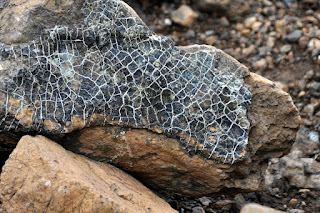There are few places in the world where one can actually walk upon the Earth's Mantle and we did exactly that when we hiked with a park ranger in the Tablelands located in Gros Morne National Park, Newfoundland. We walked upon the various peridotite rocks. These very rocks originally formed the Earth's mantle that was beneath the ancient Lapetus Ocean floor. Approximately 450 Million years ago, when Europe, Africa and North America collided, this Lapetus Ocean closed, forcing a portion of the earth's mantle to the Earth's surface. From this the Tablelands were formed. The Tablelands looking a bit like a scorched desert are actually covered with what is know as peridotite. Peridotite is rock from the Earth's mantle, it is void of nutrients and contains high concentrations of iron, magnesium, chromium, and nickel . The rock's has high iron content is what gives these rocks their orange color, as these rocks are literally rusting away. There are few plants and most are rare that have become able to survive in the tablelands area, as it takes a rare plant to be able to survive the toxic metals, lack of nutrients, freezing environment and high velocity winds. On our hike, though the names have left us, the ranger brought us over these earth mantle rocks to show us several of these plants (we were instructed to be very careful not to step on any was many, though small, could be decades old). Our favorite was a moss that looks hard, but when you touch it, it feels like a large, yet very dense sponge. We were told, that this sponge like moss is what is creating the waterfall and flow of water from the top of the table. The rocks that are near the water, many we were shown have formed a green serpentine. We were so glad we took the ranger led hike as the geology in this area is unique and the ranger did a good job sharing her knowledge.
Also while in Gros Morne we visited many other interesting areas including Rocky Harbour, Lobster Cove Head Lighthouse, the Norris Point area, the Wildlife Museum and the Bonne Bay Marine Center. The Wildlife museum gave us a chance to see wildlife of the area up close and the Marine Center too had live species from this arctic area. While we leave for St. Barbe tomorrow, we will return here again in 2 weeks when we head back south once again. On that return we are booked to take the Fjord trip (Western Brook Pond) which we are looking very forward to.
Teri is reading along our travels a book that defines Newfoundland terms and lore. So as we travel and post our Newfoundland journeys we have decided to finish each post with a bit of Newfoundland trivia. We hope that our reader's enjoy.
Newfoundland Trivia- We start with one of the most well known customs here, Mummering which is a 12 days of Christmas tradition. Friends dress in disguise and often head out in groups. If a group of Mummers are invited into a house they are supposed to perform in some way such as dance, music or comedy. The tradition is thought to have come from England and Ireland. The tradition is making a larger come back after the introduction of the Mummers song in 1982 Mummers Song
Also while in Gros Morne we visited many other interesting areas including Rocky Harbour, Lobster Cove Head Lighthouse, the Norris Point area, the Wildlife Museum and the Bonne Bay Marine Center. The Wildlife museum gave us a chance to see wildlife of the area up close and the Marine Center too had live species from this arctic area. While we leave for St. Barbe tomorrow, we will return here again in 2 weeks when we head back south once again. On that return we are booked to take the Fjord trip (Western Brook Pond) which we are looking very forward to.
Teri is reading along our travels a book that defines Newfoundland terms and lore. So as we travel and post our Newfoundland journeys we have decided to finish each post with a bit of Newfoundland trivia. We hope that our reader's enjoy.
Newfoundland Trivia- We start with one of the most well known customs here, Mummering which is a 12 days of Christmas tradition. Friends dress in disguise and often head out in groups. If a group of Mummers are invited into a house they are supposed to perform in some way such as dance, music or comedy. The tradition is thought to have come from England and Ireland. The tradition is making a larger come back after the introduction of the Mummers song in 1982 Mummers Song
Tableland Gros Morne National Park, Newfoundland Rare Arctic Succulent Gros Morne National Park, Newfoundland Arctic Plant in the Earth's Mantle Gros Morne National Park, Newfoundland Green Serpentine on Earth's Mantle Rocks Gros Morne National Park, Newfoundland The Tickle Gros Morne National Park, Newfoundland Neddy Harbour Gros Morne National Park, Newfoundland Killick (How anchors were made before metals were common) Newfoundlanders used to say that a pregnant woman had 'A rock in her killick' (instead of a bun in the oven) Rocky Harbour Wildlife Museum Gros Morne National Park, Newfoundland Blue Lobster Bonne Bay Marine Center Gros Morne National Park, Newfoundland Lobster Cove Head Lighthouse Gros Morne National Park, Newfoundland |









No comments:
Post a Comment